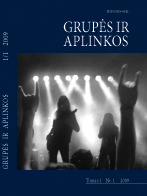Simbolinių pasaulių kūryba, gamyba ir kolonizacija
Creation, Manufacture and Colonization of Symbolical Worlds
Author(s): Gintautas MažeikisSubject(s): Cultural Essay, Political Essay, Societal Essay
Published by: Vytauto Didžiojo Universitetas
Keywords: ekonomikos subkultūrizacija; subkultūra; simbolinis pasaulis; multikultūralizmas; subculturalization of economics; subculture; symbolic world; multiculturalism
Summary/Abstract: Multiculturalism encompasses a few directions of intercultural communication and cooperation and several directions of subculturalization of economy. The most popular sphere of intercultural cooperation and conquest is international relations. There are most important national ones in this case. Another big cluster of multicultural relations is inter-class relations. By this I mean, for example, friendship and war between the bourgeoisie and proletariats or among the lower, middle and low classes. With regard to interculturalism, the third very popular topic for consideration is gender-based communication, male and female cultural features as well as criticism of patriarchal and homophobic discourses. The fourth important topic is intersubcultural communication including inter-racial dialogues. The interpretation of inter-clan and inter-cast communication as a form of multiculturalism is, however, less popular. Multicultural relations create a necessary field for the spread of images, symbols and artifacts, for example, the spread of proletariat revolutionary images between young circles of the bourgeoisie. It is also a form of migrating reality. In order to maintain the necessary fields for communication and cooperation, multiculturalism embraces the critique of hegemony, segregation, alienation, exploitation, invisible walls and glass ceilings in all spheres. One of the most popular approaches to international relations is the approach of postcolonial studies. The considerations of postcolonial studies on the invisible hegemonic rules are important for the imagine communities like modern neotribalism or religious New Age. It is, however, not only cooperation and collaboration that sustain the field of migrating reality. Modern intercultural relations also depend on the strategies and tactics of postmodern subcultural competition, colonization, usurpation and occupation. Biology and zoology give models for postmodern colonization. Nevertheless, what does postmodern colonization mean? What are the conditions for it? In my opinion, the growing diversity of communities, the subculturalization of economy and the development of alternative forms of civic activities make an important impact on the contemporary forms of colonization. There are many tactics of colonization. One of them is spreading infection. Nietzsche considered Christianity as a particular form of infection among Celtic and Germanic peoples. Colonization does not mean annihilation. In the case of colonization, a new culture grows on the roots of the old one. However, for some time, old cultures could be awoken. According to Nietzsche, an anti-Christian noble spirit, the noble Celtic perception of the world was reviled in the writings of Voltaire. Today it is very popular to use the term “infection” for the description of new colonizations by fashion, popular symbols, styles of life or forms of behaviour. Economic subculturalization presupposes the development of the s
Journal: Grupės ir aplinkos
- Issue Year: 2009
- Issue No: 1
- Page Range: 29-48
- Page Count: 20
- Language: Lithuanian

